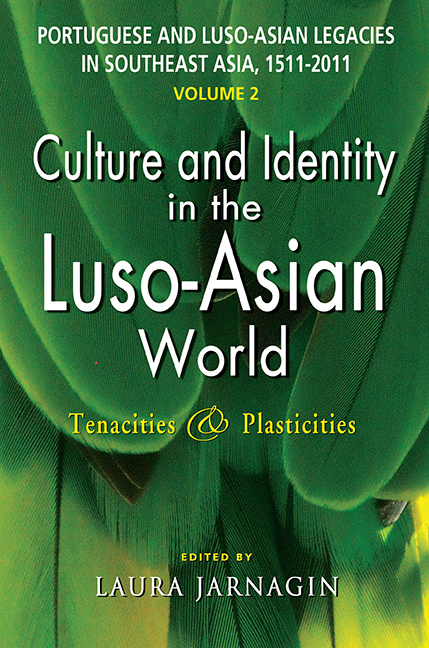 Portuguese and Luso-Asian Legacies in Southeast Asia, 1511-2011, vol. 2
Portuguese and Luso-Asian Legacies in Southeast Asia, 1511-2011, vol. 2 Book contents
- Frontmatter
- Contents
- List of Figures and Tables
- Preface
- List of Contributors
- Glossary
- Introduction: The Qualitative Properties of Cultures and Identities
- Part One Crafting Identity in the Luso-Asian World
- 1 Catholic Communities and Their Festivities under the Portuguese Padroado in Early Modern Southeast Asia
- 2 A “Snapshot” of a Portuguese Community in Southeast Asia: The Bandel of Siam, 1684–86
- 3 The Colonial Command of Ceremonial Language: Etiquette and Custom-Imitation in Nineteenth-Century East Timor
- 4 Remembering the Portuguese Presence in Timor and Its Contribution to the Making of Timor's National and Cultural Identity
- Part Two Cultural Components: Language, Architecture and Music
- Part Three Adversity and Accommodation
- Appendix: Maps
- Bibliography
- Index
- Titles in the Nalanda-Sriwijaya Studies Centre Series
2 - A “Snapshot” of a Portuguese Community in Southeast Asia: The Bandel of Siam, 1684–86
from Part One - Crafting Identity in the Luso-Asian World
Published online by Cambridge University Press: 21 October 2015
- Frontmatter
- Contents
- List of Figures and Tables
- Preface
- List of Contributors
- Glossary
- Introduction: The Qualitative Properties of Cultures and Identities
- Part One Crafting Identity in the Luso-Asian World
- 1 Catholic Communities and Their Festivities under the Portuguese Padroado in Early Modern Southeast Asia
- 2 A “Snapshot” of a Portuguese Community in Southeast Asia: The Bandel of Siam, 1684–86
- 3 The Colonial Command of Ceremonial Language: Etiquette and Custom-Imitation in Nineteenth-Century East Timor
- 4 Remembering the Portuguese Presence in Timor and Its Contribution to the Making of Timor's National and Cultural Identity
- Part Two Cultural Components: Language, Architecture and Music
- Part Three Adversity and Accommodation
- Appendix: Maps
- Bibliography
- Index
- Titles in the Nalanda-Sriwijaya Studies Centre Series
Summary
The Portuguese expansion throughout mainland Southeast Asia, with the exception of Malacca, was characterized primarily by its “private” or “informal” attribute — that is, it was based on the connivance of local authorities rather than on effective territorial occupation by Portuguese forces. Furthermore, the actors on the Portuguese side were, for the most part, merchants and veteran soldiers of the Portuguese Estado da Índia, accompanied by a relatively small number of missionaries from the Dominican, Franciscan and Augustinian orders, as well as Jesuit priests. Since the beginning of the sixteenth century, they had settled in communities of limited numbers, scattered mostly around the main Southeast Asian capitals or important cities. The history of this kind of community, known as a bandel, has yet to be fully explored and articulated. This chapter is a step towards this goal, which it takes by analysing certain cultural aspects of the bandel of Siam in Ayutthaya at the end of the seventeenth century, after about 160 years of the Portuguese presence in the region. During the seventeenth century, the role of the mestizos in the settlement process became more and more relevant as the Portuguese communities strengthened their connections to the local environment. One cannot address such Portuguese communities without questioning their own notion of “Portugueseness”, however, and doing so requires an exploration of themes such as identity construction, cultural practices, and survival strategies.
EXPLORING THE SOCIAL WORLD OF THE SIAMESE-PORTUGUESE BANDEL
In 2003, a description of the embassy that Pero Vaz de Siqueira led to Siam in 1684 was published by Leonor de Seabra, which has recently been translated into English. It is one of the most important documents from the official Portuguese side dealing with Luso-Siamese relations at the end of the seventeenth century. In addition to the official account made by the embassy's secretary, the publication includes several letters pertaining to the mission, making this publication quite a comprehensive source for academic work with its more than 350 pages of documents covering the period 1684–86.
- Type
- Chapter
- Information
- Portuguese and Luso-Asian Legacies in Southeast Asia, 1511-2011, vol. 2Culture and Identity in the Luso-Asian World: Tenacities & Plasticities, pp. 44 - 66Publisher: ISEAS–Yusof Ishak InstitutePrint publication year: 2012


